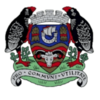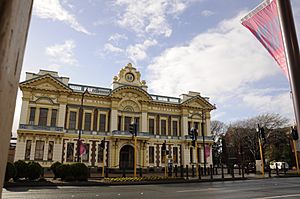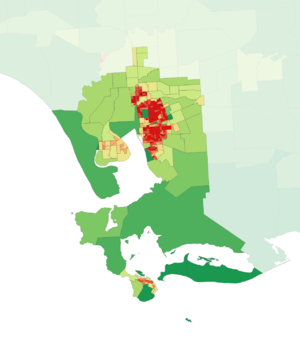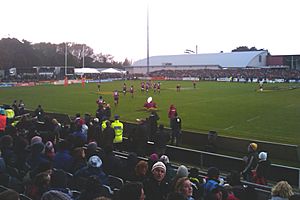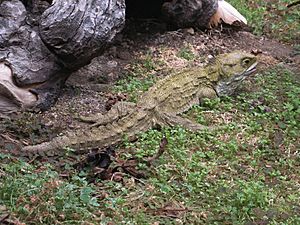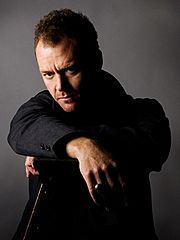Invercargill facts for kids
Quick facts for kids
Invercargill
Waihōpai (Māori)
|
||
|---|---|---|
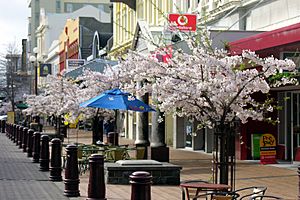
Spring in 2005, Esk Street, Invercargill
|
||
|
||
| Motto(s): | ||
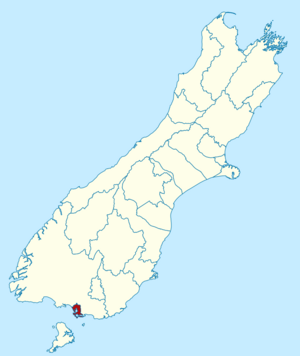
Invercargill in the South Island
|
||
| Country | New Zealand | |
| Island | South Island | |
| Region | Southland | |
| Communities | Bluff | |
| Settled by Europeans | 1853 | |
| Named for | Inbhir – Scottish Gaelic for river's mouth and William Cargill | |
| Area | ||
| • Territorial | 389.92 km2 (150.55 sq mi) | |
| • Urban | 62.95 km2 (24.31 sq mi) | |
| Population
(June 2023)
|
||
| • Territorial | 57,900 | |
| • Density | 148.49/km2 (384.6/sq mi) | |
| • Urban | 51,000 | |
| • Urban density | 810/km2 (2,098/sq mi) | |
| Demonym(s) | Invercargillite | |
| Time zone | UTC+12 (NZST) | |
| • Summer (DST) | UTC+13 (NZDT) | |
| Postcode(s) |
9810, 9812
|
|
| Area code(s) | 03 | |
| Local iwi | Ngāi Tahu | |
Invercargill (pronounced IN-vər-KAR-ghil), also known as Māori: Waihōpai, is New Zealand's most southern and western city. It's also one of the southernmost cities on Earth! This city is the main business hub for the Southland area. Invercargill sits on the wide Southland Plains, east of the Ōreti River. It is about 18 kilometres north of Bluff, the South Island's southernmost town. The area is surrounded by rich farmland, conservation land, and marine reserves. These include Fiordland National Park and the Catlins coastal region.
Many streets in Invercargill, especially in the city centre, are named after rivers in Scotland. You'll find main streets like Dee and Tay. Other streets are named after rivers such as the Tweed, Forth, Tyne, Esk, Don, Ness, Yarrow, Spey, Eye, and Ythan.
In 2018, the city's population was 54,204. This was an increase from previous years, showing the city is growing.
Contents
- What's in a Name? Understanding Invercargill's Origins
- A Look Back: Invercargill's History
- Exploring Invercargill's Location
- Who Lives Here? Invercargill's Population
- Invercargill's Economy and What It Offers
- Invercargill's Culture
- Sports in Invercargill
- Music from Invercargill
- Learning in Invercargill: Schools and Colleges
- Getting Around: Transport in Invercargill
- City Services: Infrastructure and Facilities
- Famous People from Invercargill
- Global Connections: Sister Cities
- See also
What's in a Name? Understanding Invercargill's Origins
The name "Invercargill" has two parts. "Inver" comes from a Scottish Gaelic word, inbhir, which means "a river's mouth." The "Cargill" part honours Captain William Cargill. He was the leader of the Otago Province at the time, and Southland was part of Otago back then.
The Māori name for the city is Waihōpai. This name comes from the Waihopai River. Some people think it might be a changed version of Waiopai, which means "water or stream of Pai."
A Look Back: Invercargill's History
Europeans and Māori first met a lot in the Southland area, especially whalers and missionaries. In 1853, Walter Mantell bought the Murihiku land from local Māori tribes for European settlement. Otago, which included Southland, was planned to be settled by the Free Church, a group from the Presbyterian Church. More people came when gold was found in Central Otago in the 1860s. Even today, some people in Southland speak with a Scottish accent, especially in the countryside.
In 1856, people asked Thomas Gore Browne, the Governor of New Zealand, for a port at Bluff. Because of the Otago gold rush, more people moved to the Bluff area in the 1860s. Governor Browne agreed to the port and named the settlement north of it Invercargill. The city's main surveyor was John Turnbull Thomson, a British engineer.
In 1861, Southland Province separated from Otago because of political disagreements. However, Southland had money problems and had to rejoin Otago in 1870. The system of provinces ended completely in 1876. Invercargill's population was less than 2,500 in 1874, as many people moved to bigger cities up north. In the 1880s, dairy farming grew in Southland, helping the economy with butter and cheese exports.
For 40 years, from 1905 to 1945, it was not allowed to sell alcohol in Invercargill. This rule was voted in by local people and later ended by soldiers returning from World War II. After the rule ended, a group of citizens convinced the government to give the Invercargill Licensing Trust the only right to sell alcohol in the city. This trust uses its profits to improve city facilities. Even now, you can't buy alcohol in supermarkets in Invercargill.
In recent years, the city has gained attention because of its mayor, Tim Shadbolt. He is known for being colourful and outspoken. He was once a student activist and a mayor of another city before coming to Invercargill.
Exploring Invercargill's Location
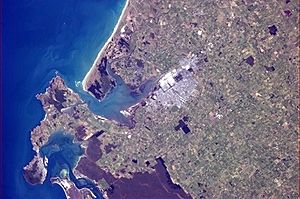
Invercargill is the southernmost city in the Commonwealth of Nations. It is located on the very fertile Southland Plains, which are some of the best farmlands in New Zealand. The southern part of Invercargill is on the shore of the New River Estuary. The northern parts are on the banks of the Waihopai River. About 10 kilometres west of the city centre is Oreti Beach. This is a long sandy beach that stretches from Sandy Point to nearby Riverton.
 |
Te Anau and Fiordland National Park | Winton and Queenstown | Gore and Dunedin |  |
| Riverton and Fiordland National Park | The Catlins | |||
| Bluff |
Who Lives Here? Invercargill's Population
The Invercargill City area covers about 389.92 square kilometres. As of 2018, it had an estimated population of 54,204 people. This means there were about 139 people per square kilometre. This number includes 47,844 people in the main Invercargill urban area and 1,854 people in the Bluff urban area. The rest live in smaller settlements and rural areas nearby.
| Historical population | ||
|---|---|---|
| Year | Pop. | ±% p.a. |
| 2006 | 50,325 | — |
| 2013 | 51,696 | +0.38% |
| 2018 | 54,204 | +0.95% |
| 2023 | 55,599 | +0.51% |
In the 2023 New Zealand census, Invercargill City had a population of 55,599. This was an increase of 1,395 people (2.6%) since the 2018 census. The median age was 40.0 years. About 18.4% of people were under 15 years old, and 18.4% were 65 or older.
People in Invercargill come from many backgrounds. In the 2023 census, 82.2% identified as European (Pākehā). Also, 19.4% identified as Māori, 4.7% as Pasifika, and 7.6% as Asian. English is spoken by most people (97.1%), while 3.7% speak Māori language.
When it comes to religion, 33.0% of people identified as Christian. About 54.6% said they had no religion.
Of those aged 15 and older, 13.2% had a university degree or higher. The average income was $39,900. About 51.6% of people aged 15 and over were employed full-time.
Invercargill's Urban Area Population
The main urban area of Invercargill covers about 62.95 square kilometres. Its estimated population in 2018 was 47,844 people. This means there were about 760 people per square kilometre.
| Historical population | ||
|---|---|---|
| Year | Pop. | ±% p.a. |
| 2013 | 45,531 | — |
| 2018 | 47,844 | +1.00% |
| 2023 | 48,987 | +0.47% |
In the 2023 New Zealand census, the Invercargill urban area had 48,987 people. This was an increase of 1,143 people (2.4%) since the 2018 census. The median age was 39.2 years. About 18.5% of people were under 15 years old, and 18.4% were 65 or older.
In the urban area, 81.4% identified as European. Also, 18.8% identified as Māori, 4.9% as Pasifika, and 8.3% as Asian. English was spoken by 96.9% of people.
About 33.4% of people in the urban area identified as Christian. About 54.1% said they had no religion.
Of those aged 15 and older, 13.5% had a university degree or higher. The average income was $39,500. About 51.5% of people aged 15 and over were employed full-time.
Invercargill's Economy and What It Offers
Invercargill is home to the Southern Institute of Technology (SIT). This school offers a "zero-fees" scheme, meaning New Zealand students only pay for materials, not tuition. This scheme has helped the city grow again after its population had been shrinking. A big reason for Invercargill's recent growth is the dairy industry boom. There's a high demand for New Zealand milk, cheese, and butter. New dairy factories and meat processing plants have opened in the Southland Region.
Invercargill is part of the Southern Scenic Route, a special tourist road. This makes it easy to take day trips to places like Queenstown, Stewart Island, Dunedin, Te Anau, and Fiordland.
Community Support: Licensing Trusts
The Invercargill Licensing Trust (ILT) is a major supporter of community projects in Invercargill. The ILT Foundation gives out about $10 million each year to over 500 organisations. The trust has also helped build important city facilities like the ILT Stadium Southland and the Invercargill Velodrome. They also support local sports teams such as the Southern Steel, Southland Sharks, and Southland Stags.
The Community Trust of Southland was created when Westpac bought Trust Bank Southland. About $150 million was set aside for the people of the Southland regions, including Queenstown and Arrowtown. This trust is known for being one of New Zealand's best community trusts. It gives out between $7 million and $10 million in grants each year. Since it started, it has given almost $140 million to various projects and programmes.
Local Business: Brewing and Banking
Invercargill used to have the Invercargill Brewery, which was the southernmost beer manufacturer in New Zealand. It won international awards. However, the company closed down in 2018.
SBS Bank, or the Southland Building Society, started in Invercargill in 1869. It was created to help local communities with their financial goals. Today, SBS Bank is a full-service bank offering many banking products. Its main office is still in Invercargill.
Growing Tourism in Invercargill
Invercargill's tourism industry is growing. Popular attractions include E Hayes, Bill Richardson Transport World, Dig This, and Classic Motorcycle Mecca. These places bring many visitors to the area.
Invercargill's Culture
Murihiku Marae is located in Invercargill. It is a marae (a meeting ground) for the Waihōpai Rūnanga branch of Ngāi Tahu, a Māori tribe. It includes Te Rakitauneke wharenui (meeting house).
In the late 1880s, a small magazine called Literary Southland was published in Invercargill. It featured stories and memories from the early days of the region. While not well-known today, it was quite popular and sometimes caused debate back then.
Sports in Invercargill
Invercargill has a strong sports scene. The Southern Sting (now Southern Steel) netball team won seven national titles between 1999 and 2007. The local rugby team, the Southland Stags, held the Ranfurly Shield from 2009 to 2010. They have also reached the NPC Semi-finals many times.
Southland has one of the highest numbers of sports participants in New Zealand. Popular sports include rugby union, netball, basketball, cricket, and hockey. Many professional athletes have come from Southland. Invercargill also has excellent sports facilities. These include an indoor velodrome, an Olympic-sized swimming centre, a 20,000-seat rugby stadium, and international fields for hockey and cricket.
The city's 4500-seat indoor stadium was badly damaged in 2010 when its roof collapsed after heavy snowfall. Invercargill is home to four professional sports teams:
- Southland Stags (Rugby)
- Spirit FC (Association Football)
- Southern Steel (Netball)
- Southland Sharks (Basketball)
Invercargill has the only indoor cycling velodrome in the South Island. This 250-metre wooden track is the home of Track Cycling in Southland. The Invercargill Licensing Trust supports the velodrome, which is located at Stadium Southland.
For horse racing fans, there is a racecourse on Racecourse Road, on the east side of the city.
Two motorcycle speedway tracks are located close to each other, about 10 kilometres west of the city centre near Oreti Beach. The Oreti Park Speedway and the Riverside Speedway host important events. Oreti Park Speedway has even held qualifying rounds for the Speedway World Championship.
Music from Invercargill
The "Invercargill March" is a famous tune played around the world. It was written by Alex Lithgow, who went to Invercargill Grammar School (now Middle School). In his book, Invercargill – 150 Years, Lloyd Esler wrote that Alex Lithgow did a great favour for Invercargill by naming his famous march after his childhood home. The "Invercargill March" is a favourite for brass bands, and the name "Invercargill" is heard by audiences worldwide. There is only one Invercargill in the world – this one.
When Invercargill hosted a national brass band contest in 1909, Alex's brother Tom asked for a special piece for the competition. Alex offered this march to the city.
Learning in Invercargill: Schools and Colleges
Colleges in Invercargill
- The University of Otago College of Education has its southernmost campus in Invercargill.
- Invercargill is home to the Southern Institute of Technology (SIT). This polytechnic offers university-level qualifications.
- The Southern Wings Aviation College operates from Invercargill airport. It provides training for aviation licences and the New Zealand Diploma in Aviation.
High Schools in Invercargill
All high schools in Invercargill teach students from Year 7 to Year 13. This change happened after a review by the Ministry of Education in 2004.
- James Hargest College is in northern Invercargill and has about 1,800 students.
- Aurora College opened in 2005.
- Southland Girls' High School became the first state school in New Zealand to teach only girls from Year 7 to Year 13 in 2005.
- Southland Boys' High School became the first state school in New Zealand to teach only boys from Year 7 to Year 13 in 2005.
- Verdon College is a Catholic school for both boys and girls, with about 700 students.
- Te Wharekura o Arowhenua is a Māori school on Tweed Street. It teaches students from Year 1 to Year 15.
Primary Schools in Invercargill
Most primary schools teach students from Year 1 to Year 6.
- New River Primary School is a co-ed school in the South Invercargill area.
- St Joseph's is a small co-ed Catholic school near St Mary's Basilica.
- St Theresa's is a co-ed Catholic primary school in North Invercargill.
- St Patrick's is a co-ed Catholic primary school in Georgetown.
- Ascot Community School is the only public co-ed school in the Hawthorndale area.
- Fernworth Primary is a co-ed school in the Heidelberg area.
- Windsor North School is a co-ed school in the Rosedale area.
- Waverley Park School is a co-ed school in the Waverley Park area.
- Waihopai School is a co-ed school in the Waihopai area.
- Salford School is a co-ed school in the Rosedale area.
- St John's Girls' School has a Christian focus.
- Sacred Heart Primary School is a co-ed Catholic family school serving the northern suburbs.
- Donovan Primary School is a co-ed school in the Grasmere area.
- Otatara Primary School is a co-ed school in the Otatara area.
- Myross Bush Primary School is a co-ed school in the Myross Bush area.
- Newfield Park School is a co-ed school in Newfield.
- Southland Adventist Christian School is a small co-ed school in the Waikiwi area with a Christian focus.
- Middle School is a co-ed school located in the middle of Invercargill.
- Westmount School is a private school in the Clarendon area.
Getting Around: Transport in Invercargill
Invercargill has six bus routes run by BusSmart INVERCARGILL. These routes are Clifton 1, Kingswell 2, Newfield 3, Hargest 4, Waverley 5, and Waikiwi 6. The buses start from the BusSmart Hub outside Cotton On Group Invercargill on Tay Street. BusSmart uses the Bee Card, which is used in most regions of New Zealand. There are no buses on Sundays or public holidays.
City Services: Infrastructure and Facilities
The main hospital in Invercargill is Southland Hospital, located in Kew. It is a public hospital managed by the Southern District Health Board.
Electricity in most of Invercargill is supplied by Electricity Invercargill. In some suburbs like Waikiwi, Grasmere, Kew, and Kingswell, and the surrounding rural areas, the electricity network is owned by The Power Company. Both networks are managed by Powernet. Electricity comes from Transpower's national grid at two substations: Invercargill (Racecourse Road) and North Makarewa.
Famous People from Invercargill
Many notable people have come from Invercargill:
- Peter Arnett – a war correspondent for NBC.
- Peter Beck – founder and CEO of Rocket Lab.
- Eliza Ann Brown - first president of the first WCTU organisation in New Zealand (1884).
- Oliver Bulleid – a famous railway locomotive designer, born in Invercargill in 1882.
- Nathan Cohen – an Olympic and two-time world champion rower.
- Marton Csokas – an actor.
- Dave Cull - a former TV host and mayor of Dunedin.
- Corey Flynn – a hooker for the All Blacks rugby team.
- Ernest Godward – inventor of the spiral hairpin and a petrol economiser.
- Dene Halatau – a rugby league player for the Wests Tigers.
- Brigadier James Hargest – a New Zealand military officer and politician.
- Rowena Jackson – a Royal Ballet prima ballerina.
- Gerard Johnstone - a film director.
- Jason Kerrison – singer/songwriter for the band Opshop.
- Chris Knox – a musician, cartoonist, and filmmaker.
- Alex Lithgow – a composer, musician, and conductor.
- Bill Manhire – New Zealand's first poet laureate.
- Herbert James "Burt" Munro – a famous motorcycle enthusiast and racer who set a land speed record.
- Donald Murray – known as the "Father of the Teletypewriter."
- Mils Muliaina – an All Blacks rugby player.
- Anton Oliver – an All Blacks rugby player.
- Warren Parry – a darts player.
- Suzanne Prentice – a musician.
- Lesley Rumball – a former captain of the Silver Ferns netball team.
- Tom Scully – a cyclist and 2014 Commonwealth Gold Medallist.
- Tim Shadbolt - a former mayor of Invercargill.
- Glen Thomson – a cyclist, 1998 Commonwealth Gold Medallist.
- David Strang – inventor of instant coffee in 1890.
- Garfield Todd – a former Prime Minister of Southern Rhodesia.
- Joseph Ward – a former Prime Minister of New Zealand.
- Jeff Wilson – a "Double All Black" (played for both the All Blacks rugby team and the Black Caps cricket team).
- Penny Simmonds – a New Zealand Politician.
Global Connections: Sister Cities
Invercargill has special connections with other cities around the world, called "sister cities."
Current Sister Cities
- Kumagaya, Japan (since 1993)
- Suqian, China (since 2013)
Former Sister City
- Hobart, Australia
See also
 In Spanish: Invercargill para niños
In Spanish: Invercargill para niños


